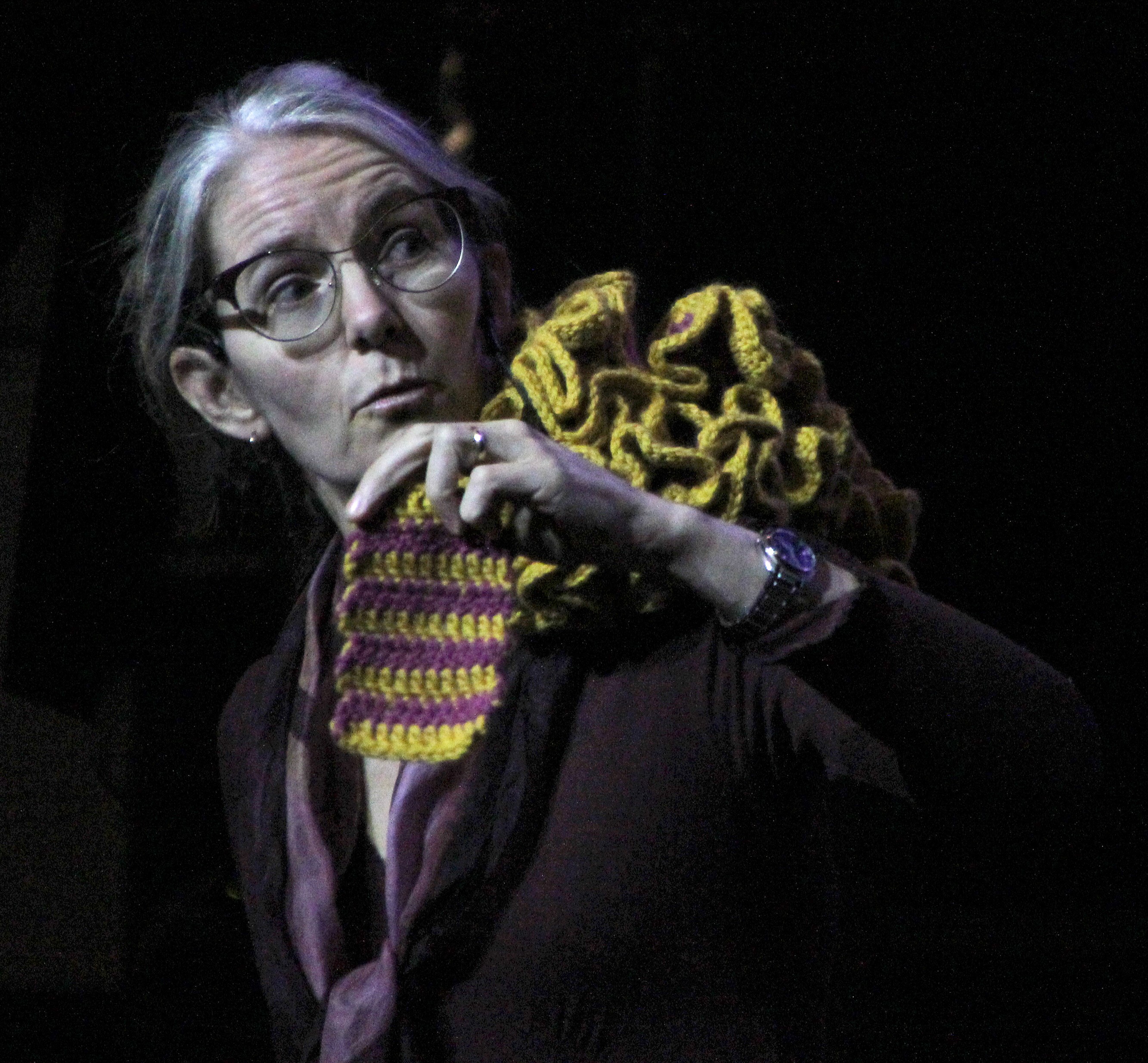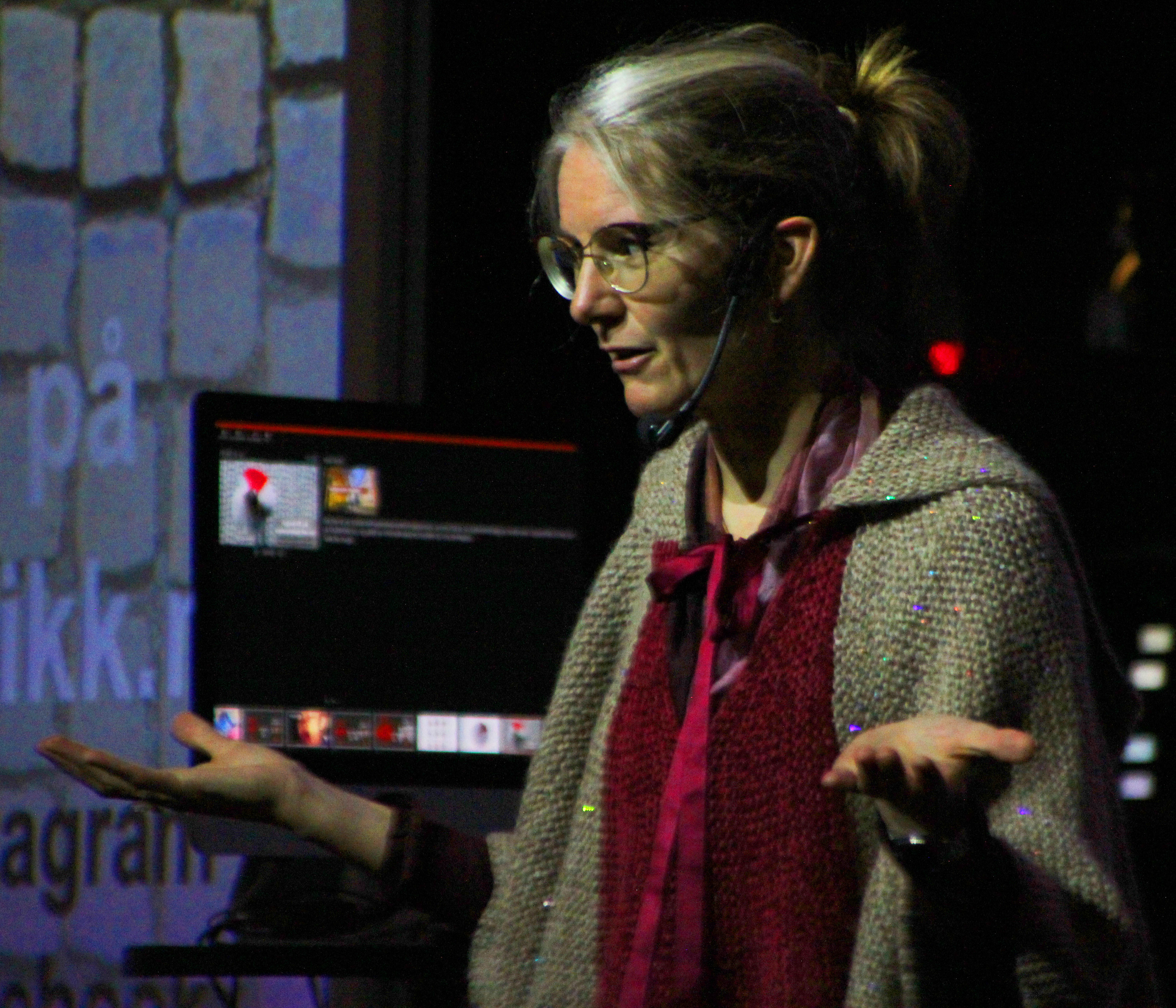As part of the national Research Days, NMBU hosts a science show for 10th graders, introducing them to different concepts and possibilities in the sciences. This year, statistician Kathrine Frey Frøslie took the stage to discuss the importance of vaccination programs, and the mathematics behind the spread of disease.
"How many of you know what a statement piece is?" Kathrine scans the audience. Whispers and a few giggles resonate throughout the auditorium. The boys in the backrow nudge each other, daring one another to raise a hand. Images of fashionistas with chunky earrings flash across the screen. What do they and a statistician with a passion for communication have in common?
"After I finished my doctoral degree, I decided to become an influencer, so I started a knitting blog."
Kathrine’s second sentence is met with baffled faces as she engages the crowd. For if fashion bloggers have their signature looks then Kathrine wears her own statement pieces, clothes she designs, knits and blogs about to communicate research and statistics. Today she will influence the youngsters in her whooping cough poncho, a creation in alpaca wool that shows the percentage of people who need to be vaccinated to avoid an epidemic of whooping cough. In other words, a wearable pie chart that functions as both style and substance.

"The blogosphere should not just be about makeup tips and fashionable diets. Researchers who blog can contribute with knowledge and content."
Kathrine then gestures at terrifying subjective stories of individuals in the news. For who hasn’t given in to clickbait, the headline that screams "Marie, aged 18, is bound to a wheelchair after the HPV vaccine". Such personalized and sensationalist stories may flaw our judgement. Instead, she encourages the students to look at the logic of numbers because "Statistics tells the story of the many, and not the individual." In a world of makeup tips and spending pressure, fake news and "alternative facts", research results inject substance in the public discourse; statistics form the narrative separating reality from fiction.

In the medical world, the consequences of ignoring vaccination programs can take on epidemic proportions. Epidemics occur when the basic reproduction number is greater than one – that is to say, when one sick person infects, on average, more than one person. This number tells us how quickly a disease will spread. Take measles, for example, one of the most contagious diseases. On average, each sick person has the potential to infect 12 to 18 healthy individuals. In a non-vaccinated population, a measles epidemic will spread like a grass fire.
To illustrate the basic reproduction number, Kathrine uses visual aids. She holds up swatches of "infected" crochet. The swatch with a basic reproduction number of one has an even width throughout, with each row of stitches representing a week of illness. Each week, one person on average catches and then transmits the disease further to another person. When the basic reproduction number is less than one, the spread of disease will slow and halt, as each week fewer people get sick.
The piece Kathrine now holds up looks like something I would have crocheted by accident, as it gradually narrows towards the top. It also illustrates the benefits of a vaccination program – each week fewer people get sick because they are protected. What happens if the basic reproduction number is greater than one and they aren’t protected? Kathrine waves a coral-shaped crocheted mass of exploding colors. The rows of stitches have expanded like a tumor, an epidemic rages.

Kathrine drives home the benefits of vaccination by soliciting audience participation, singling out a girl. "If you are sick, and the basic reproduction number is two, how many people will you infect?"
A boy and a girl in the row in front of her are asked to stand up. Each one of them, in turn, can infect two people. It’s easy to see how quickly disease can spread under this scenario, in this auditorium. What percentage of the population needs to be vaccinated to get the disease under control, to get the basic reproduction number back down to one or below? One of the two students will need to sit down – in other words, 50% of the population will need to be vaccinated.
In an ideal world, everyone would be vaccinated, but that just isn’t possible, Kathrine emphasizes. The very young, very old, and those with a weakened immune system can’t risk the side effects that come with vaccination. It’s up to the rest of us to keep disease in check by following a vaccination program, both for our benefit and the benefit of the population at whole. This is what we call "herd immunity".

Back to that whooping cough poncho, which is based on a disease with a basic reproduction number of 5.5. Kathrine pulls it out now with a flourish and does a little twirl on stage. The poncho flares and fans out – a sand brown confection studded with sequins, and with a raspberry red section down the front. The brown represents the percentage of people who need to be vaccinated in a population to avoid an epidemic: 4.5 out of 5.5, that is, 82%. The red represents the non-vaccinated minority of 18%. It’s stark and stunning and in-your-face statistics. As the auditorium doors open, the images of the aggressive crocheted epidemic and her flaring poncho will linger in the minds of the students. Hopefully this will contribute towards the spread of fact-based knowledge in the world of bloggers, to increase the basic reproduction number of statistical fascination.